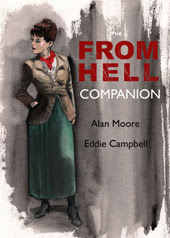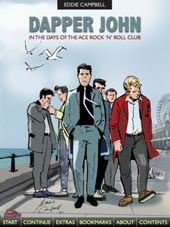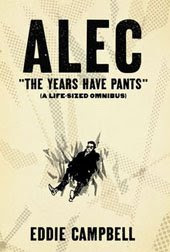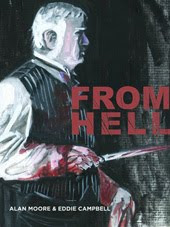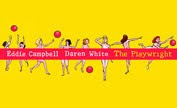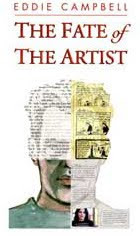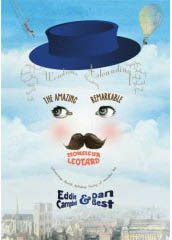M arjane Starapi is interviewed in the New York Times Magazine- by DEBORAH SOLOMON- October 21- and is made to waste the first three paragraphs defining terms. She is called upon to justify what is taken to be some kind of collective enterprise.
You’ve just turned your acclaimed series of graphic novels into a full-length animated film, “Persepolis,” an oddly charming tale about the brutal subject of growing up in Iran during the Islamic revolution. Would you still describe yourself mainly as a graphic novelist?
I don’t very much like this term of graphic novel. I think they made up this term for the bourgeoisie not to be scared of comics. Like, Oh, this is the kind of comics you can read.
Do you think cartoonists have received their artistic due?
No. People either like to write or they like to draw. And we like to do both. We’re like the bisexuals of the culture. People don’t have any problem if you are a homosexual or if you are a heterosexual, but if you are a bisexual, they have more of a problem with you.
The above comes right at a time when the conceptual world of 'comics,' the collective sense of what 'the medium' is supposed to be about, is collapsing into the soulless vacuum of conservatism at its centre. Though I should have seen the writing on the wall with Paul Gravett's
Graphic Novels: Books to change your life, with its need for a cosy sense of order and interconnectedness, it didn't occur to me until Douglas Wolk's book,
"Reading Comics: How Graphic Novels Work and What They Mean" (Da Capo, 2007), Julia Keller writing:
Chicago Tribune-aug 19 There is a vivid disparity, then, between the oft-told contemporary tale of a medium ascending in the cultural pantheon and the reality that comics are still -- comics. Even when they're gussied-up and stuck between bound covers and dubbed "graphic novels," they're still -- comics. Even when comics-based films such as the "Spider-Man" franchise and "300" are box office winners, the whiff of juvenilia still clings to comics, like the scent of grape Hubba Bubba and burned Pop-Tart. And that's just fine with Douglas Wolk.
The problem may be described as the inability of an ambitious kind of novel, which uses the elements of the simple cartoon strip for its vocabulary, to remove itself outside of the event horizon of comic book culture. I've covered this in past posts:
Ingmar Bergman is not expected to justify Star Wars, but it is usually implied that
the success of Maus in some way justifies the Dark Knight. To say that 'it's all comics' is extremely unhelpful.
Mathias Wivel describes the conservative backlash in a 1500 word essay- oct 16- though he sounds much too optimistic to me.
Lo, the pendulum swings. Things have happened so quickly in comics these last years that we are already seeing a backlash against the type of comics that broke the century-old mould and expanded the field of comics as expression and art, until recently almost universally embraced amongst ‘progressive’ comics cognoscenti. There is a new establishment in comics — graphic novels, artcomics, verité dessinée, call it what you want — and, as it should be, a conglomeration of people all set to tear it down, though not always for the same reason or with the same agenda, have emerged. At the same time, myriad new developments are taking the medium in new, and different directions that elicit critical responses even before the ink is dry. It’s only natural — the medium is in a state of evolutionary flux and the battle of redefinition these conflicting discourses are evincing is only to be expected.
I no longer find it useful to refer to it all as 'the medium.' Which medium are we talking about? I recall a conversation I once had with Dave Sim where he said that he regarded the strip cartoons in the newspaper as a separate medium from the one he was working in (comic books). I thought it made perfect sense. Satrapi certainly has no connection to comic book culture, and the question at top sounds oddly ignorant: 'Would you still describe yourself as a graphic novelist?." (Does the interviewer have an occasion in mind when she described herself thus?) There's a good youtube clip
in which she describes how she got into the graphic novel thing (in response to a question from the audience, and sensibly without stopping to argue about the term) after reading
Maus. In her inimitable way she immediately humanises the predicament with an anecdote about her grandmother.
Heidi Macdonald unintentionally lit a fuse on 12 oct at at The Beat (Publishers Weekly blog) with her review of the Chris Ware-edited
Best American Comics 2007:
Can anyone here tell a story?I relish the freedom and unselfconscious work of the new generations of cartoonists — they don’t have to live with the stigmas that seem to have scarred people like Ware, Seth and Brown in their formative years. But as good as the next gen is, the idea of crafting a story, using their imaginations, creating characters who represent their ideas and using them to play things out, doesn’t seem to have even OCCURED to most of them.
In abstract, that’s fine, but all this emphasis on the real has left a kind of disdain for people who want to tell stories. Put it this way, I’d take BONE over 50% of the stuff in BEST AMERICAN COMICS 2007 on my “best” list. There’s no shame in enjoying a fantastic tale about heroism and struggle. Sometimes the enemy is a big dragon; sometimes it’s a nagging wife and wanting to kill yourself.
The review started a bushfire and a large number of people threw in their two cents. Now, I haven't read the book under review and I have no intention of doing so, but I am puzzled as to why the existence of a book could be an annoyance to anyone whose life and comfort it does not affect in any way whatsoever. The answer in short is that conservatism desires homogeneity, in fact demands it. Swiftly, backward-looking formulae are suggested:
The Comics Blogsphere Finally Admits that Most Indie Comics are Awful- Michael Climek -oct 16:"Rather than inventing fictional characters to express ideas in a complex manner ‘artists’ nowadays only write comics of themselves sitting at a desk saying their ideas in a freakishly non-complex straightforward manner. And it’s boring as F*&k."
Labels: comics crit 1















